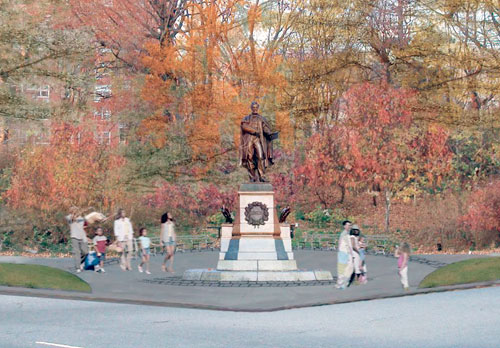Abraham Lincoln will soon upstage a Scottish gynecologist who’s been perched in Grand Army Plaza since the days of horse and buggies.
The city has secured $340,000 to haul a towering statue of Honest Abe back to its original spot — at the gateway to Brooklyn’s backyard — from exile in the Concert Grove.
“We thought he should go back to nice, prominent spot,” said park spokesman Eugene Patron. “It’s more historically accurate.”
The sculpture — which was the first Lincoln statue erected in the Union — was installed at the northern end of Grand Army Plaza in 1869. But three decades later, city leaders moved him to the lower terrace of the Concert Grove, claiming that the 16th president had been dwarfed by Prospect Park’s signature Soldiers and Sailors Memorial Arch.
A bronze bust of Civil War doctor Alexander Skene was installed nearby — and has remained there for decades.
The Lincoln statue won’t return to its exact original spot at the very top of the plaza facing Manhattan, but will stand on the north side, facing south, and this time, he’ll have decorative pavement, benches and plants surrounding him after the move is completed by the end of the year.
As such, history buffs have a few critiques. Lincoln-obsessed blogger and Park Sloper Richard Kessler thinks the plan is flawed because the Great Rail Splitter should stand facing north, as symbol of his Civil War affiliation.
Lincoln was originally facing that direction — in fact, the statue was intentionally facing the home of the wealthy Astor family, which opposed Lincoln because of his anti-slavery positions.
As such, the point of the Lincoln statue, said Kessler, was to have the president “reading the Astors the riot act from the grave!”
The city has said that Lincoln’s exile was simply due to not wanting the Great Emancipator to be overshadowed by the archway, but historians like Kessler believe that the statue was cast into exile by 19th-century officials who didn’t like what Lincoln stood for: Ending the Confederacy, freeing the slaves and restoring the Union.
It may seem strange to consider it today, but Lincoln was a controversial figure after his death, even in the North.
Rutherford B. Hayes become president in 1877, largely on his promise to remove
Union troops from the South, ending Reconstruction. A few years later, Brooklyn Park’s
commissioners, whose terms and loyalties dated back to Lincoln’s days, were replaced. Then, in 1883, the Supreme Court reversed the Civil Rights Act of 1875, further evidence that the nation had forgotten Lincoln’s legacy. By 1896, his statue was moved.
The history behind the bronze isn’t the only selling point for neighbors. Robert Minsky of Grand Army Plaza Coalition, for example, thinks the dead president will help the plaza’s image as a charming meet-up point, as opposed to an epicenter for traffic snarl.
“We’d like Grand Army Plaza to be a pleasant place to come and congregate,” he said. “Lincoln makes it more interesting.”

























